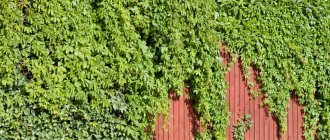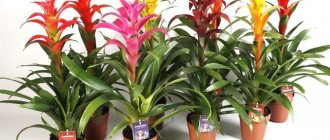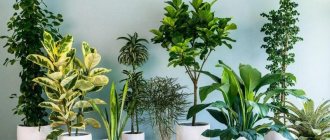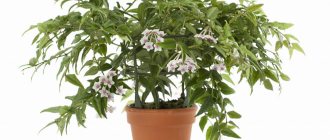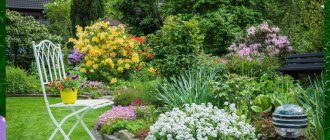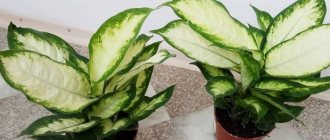Cissus
The vine of the Grape family is distinguished by its high growth rate and unpretentiousness.
The absence of sudden changes in room temperature and sufficient humidity are important for large green mass.
From an environmental point of view, cissus is very useful in the home: it releases phytoncides that help cleanse the air of pathogens. But popular superstitions attribute to him the ability to drive husbands out of the house.
Eschynanthus
Aeschynanthus is an epiphyte of the Gesneriaceae family, called “fondant” for its bright flowers of an unusual inverted shape. The capricious and demanding plant is grown using the hanging method; to gain green mass, it is worth planting several cuttings in one pot.
Afraid of direct sunlight, shade, sudden temperature changes and waterlogging.
It has a controversial reputation: along with the ability to improve the atmosphere, purify the air and simply decorate the house, it is credited with the same “husband-driver” properties as cissus.
Features of care
The main advantage of syngonium is its unpretentiousness. It quickly adapts to various conditions and has a high survival rate. Another aspect why gardeners love it so much is the rapid growth of this vine.
Air temperature
A comfortable temperature range will be 18-24° C, in winter, lower it to 17-18° C. It is possible to briefly reduce the temperature to a maximum of +10° C.
Watering and air humidity
In the warm season, abundant, but without stagnant, moisture in the pot is needed. Water as soon as the top layer of soil dries out. Drain excess water from the pan. In winter, when wintering is cool, it should be watered after the earthen clod has dried by 1-2 cm.
Liana prefers moderate air humidity. On hot days, spray the plant daily, sometimes wipe the leaves with a damp sponge. In winter, place away from heating systems. Spraying may not be necessary, but then from time to time place the plant on a tray with damp expanded clay, pebbles, and moss.
Water and spray the syngonium with softened water at room temperature.
Transfer
How to replant syngonium photo
Young vines (up to 3 years old) require replanting annually in the spring. In the future, replant every 2-3 years.
The soil must be loose, nutritious, with a neutral or slightly acidic reaction. If possible, prepare the soil mixture: take 1 part of leaf soil, turf soil, peat, add 0.5 parts of sand. Can grow hydroponically.
The container is wide and shallow. With each transplant, increase its volume slightly.
Bloom
As a rule, this plant does not bloom when grown indoors. But if it does bloom, the flower will be represented by a not very large cob, which is wrapped in a white blanket.
Air humidity
In the hot season, it is recommended to moisten the foliage regularly twice a day in the evening and morning. And to remove dust from the foliage, wipe it regularly with a damp sponge. In order to increase the level of air humidity, pour moistened expanded clay or peat into the tray and place the container with the plant on it, but the water should not touch its bottom. Under no circumstances place the flower near heating appliances.
Garter creeper
Create a support for ampelous varieties to increase decorativeness. A moss pipe works well. It is placed in the center of the pot during transplantation. It is necessary to lay a drainage layer consisting of expanded clay, clay shards and other similar materials. Then place the tube, add a third of the soil, place the plant, add soil in a circle, pressing lightly.
Feeding and pinching
Fertilizers should be applied in spring and summer. Every 2-3 weeks, feed with mineral fertilizers in liquid form.
To increase bushiness, you should pinch out the apical shoots above the 6-7th leaf.
Optimal conditions of detention
The best temperature for maintaining a flower in proper form is +22…+25°C. In winter, it is quite acceptable to warm the air in the room only to +18°C.
You can trim the vine after it produces the first 3 leaves. If necessary, any shoot must be pinched, since syngonium is absolutely not afraid of this procedure. It is especially useful to do this if the stem has become old or has dropped its leaves, then such manipulation will contribute to the formation of new shoots.
Important! Lighting for a flower should not be too strong. It is necessary to provide it with diffused light, since direct sunlight can leave burns on delicate leaves.
Ivy evergreen
Hedera is the second name of this plant of the Araliaceae family. It has a lot of useful properties and is used in medicine as an anti-inflammatory, antitussive, and healing agent.
At home, it needs diffused lighting, high humidity, spraying, and a shower.
It is credited with calming properties, the ability to neutralize negative energy, and purify the air. It is believed that single girls and young families need to have a plant. And adult ivy drives suitors away from the house and drives away husbands.
Philodendron
An evergreen plant of the Araceae family, it is popular as an indoor flower. Can be grown in hanging pots or on a support. Loves humidity and warmth, is not afraid of shade, and grows quickly.
According to signs, unmarried people should not have it - it will discourage suitors, and it should also be used with caution by married couples, since it encourages men to leave the family.
But if these are just signs, then the poisonous sap of the plant is definitely an important factor that is worth thinking about, especially if there are small children in the house.
Plants are allergens
Sadly, a fairly large number of indoor plants, often found in many homes, are allergens when they bloom.
Allergens, in addition to many of the plants listed above, include pelargonium, fern, cyclamen, rhododendron (aka azalea) and others. What reaction do they cause in humans? For example, aglaonema juice can severely irritate the skin and mucous membranes.
Hanging gardens made from pots of pelargonium. This flower can trigger an allergic attack
Fern is a strong allergen
Cyclamen during flowering can cause allergies
Dieffenbachia can decorate any windowsill thanks to its exquisite large leaves. However, it can cause tissue swelling if it enters the oral cavity. Why is this beautiful plant poisonous? Dieffenbachia can cause poisoning in a child or pet if they swallow its leaves. In addition, you need to be careful when replanting it or cutting off its leaves. In this case, you may get burned by its juice. Philodendron poses the same danger.
Move Dieffenbachia higher if there are children and four-legged pets in the house
Croton and oleander are also strong allergens, and ficus is by no means an honorable third place after them.
Tradescantia
Perennial herbaceous plant of the Commelinaceae family. It has an unusual striped color and is grown using the hanging method. Requires diffused light, regular watering, and tolerates low humidity well.
It is believed that Tradescantia absorbs electromagnetic radiation, negativity, and anger.
If suddenly a plant dies, you should not just throw it out, but bury it away from the house - many believe that it has absorbed bad energy. At the same time, there is an opinion that it also has a bad influence - it makes a person absent-minded, forgetful, and inattentive.
Source
Is a vine in the house useful according to Feng Shui or not?
According to the ancient teachings of Feng Shui, in order for there to be harmony in the house, and for all household members to be successful in all areas of life, it is necessary that all the elements in the house are in harmony with each other, and that energy flows have a beneficial effect on a person and the sphere of his life, pulling him towards great achievements.
Correctly adjusting the energy is a real art that has been developing over many centuries and bears the world-famous name - Feng Shui. The Feng Shui system takes into account a lot of elements and when creating the right living space, everything is important, from the location of the house to the shape of the rooms, their furnishings and decorative elements. One of the important elements in any home are indoor plants, which can both improve the situation with energies in the house and, on the contrary, attract various troubles and failures.
On the one hand, indoor plants make a living space more vibrant, filled with light and warmth, they can soften the influence of energy coming from outside through windows and even absorb negative energy.
On the other hand, the choice of plants must be approached with the utmost care. Some plants can be harmful if placed incorrectly indoors.
When choosing a plant for your home, its size, leaf shape and even flower color are important.
During the flowering period, the liana becomes even more dangerous, if you believe the teachings of Feng Shui, since a flowering liana can completely block male sexual energy, leading to discord in the intimate life of spouses. As a rule, vines do not bloom often, so not everyone knows that they throw out a small, unassuming flower.
During the flowering period, a liana can make a man sexually passive, and in addition, cause serious quarrels between spouses. Indoor vines can completely destroy the energy flows in the house, causing an energy imbalance. Particularly dangerous are those vines that fall down; such plants are capable of sucking out positive energy.
In principle, these plants work as “energy plants”, and the vines are capable of creating flows through which positive energy does not accumulate in certain rooms, but rather disappears and dissipates. Since indoor vines are quite tenacious plants, it is believed that this plant owes its vitality precisely to the energy absorbed by the plant. In addition, all vines have a specific leaf shape that is completely inconsistent with Feng Shui criteria.
According to Feng Shui, indoor plants should have round or pointed leaves with white or red flowers, in this case the plants will be a kind of filter for negative energy and an accumulator of positive energy. Plants that meet the requirements of Feng Shui can reduce the outflow of positive energy in places where this outflow is possible.
Indoor vines and all climbing plants are a symbol of loneliness, so if this plant is in the bedroom, it leads to discord in family life. It is believed that vines seem to envelop all spheres of a person’s life, not giving them access to energy, as if suffocating them; perhaps these associations appeared due to some similarity of this creeping plant with a snake.
Most feng shui experts agree that vines in the home are a negative thing, but there are some loopholes where vines can be of benefit to home owners.
Lianas can be a kind of indicator of well-being in the house. Creepers are good to have in the house for those who cannot find the reason for their failures, although all the cards are in the person’s hands. Perhaps it is precisely the existing imbalance of energy in the house. Lianas in such an environment become sick, lethargic, their leaves quickly turn yellow, and growth slows down. The deterioration of the vine’s condition clearly reflects the deterioration of the energy state in the house. Lianas are often placed in rooms where water energy predominates, since this plant is able to compensate for water energy; in this case, the vines are placed in such a way that their branches stretch upward.
In addition, there are so-called “dead corners” in some houses; it is in these energy zones that the vine will come in handy, as it can completely block the flow of negative energy in such a place. In “dead zones”, vines should be positioned so that the branches fall down, so that negative energy will go into the ground and not dissipate throughout the room. The properties of plants according to the teachings of Feng Shui can vary depending on the type of plant, their shape and size, and direction of growth.
Properly placed plants in the home can greatly improve the well-being of the family. Plants located on window sills and in corners can protect against negative energy, but the choice of plants must be approached responsibly and knowledgeably.
If you want to attract love and happiness in family life, some plants are suitable, for example, cyclamen, begonia, amaryllis adiantum camellia; for success you need other plants, and others for career growth.
Lianas are among those plants that are still not very suitable for keeping in the house, because finding the right place for this plant is difficult even for many professionals, not to mention amateurs.
Did you like the article? Subscribe to the channel to stay up to date with the most interesting materials
Source
Most popular types
Tradescantia
Scindapsus
A unique decorative foliage plant that can grow in any corner of the house. This heart-shaped flower with glossy leaves of bright green or variegated colors grows very quickly. Climbing the wall, this ampel can reach a meter in height. Shade-loving and low-maintenance scindapsus require stimulating pruning, after which they form a dense crown of numerous young shoots. After this, scindapsus looks lush and spectacular.
Saxifraga shoot
A miniature plant with thin shoots hanging down to the bottom. At the age of 3, this plant produces a long peduncle, on which small white or pink flowers are formed, collected in a corymb inflorescence. Saxifraga flowers are not particularly decorative or attractive; moreover, they take away all the strength and energy from the plant. Therefore, the flower arrow is pinched even before it blooms. Saxifragas are shade-loving indoor plants, so they can be kept in any corner of the house.
Philodendron climbing
An unpretentious perennial with leaves similar to the shape of scindapsus leaves. Philodendron leaves have a rich green color, with a burgundy shade on the underside of the leaf blade. The surface of the leaves is leathery, glossy, and heart-shaped.
Ivy
This is perhaps the most common inhabitant of residential buildings and apartments. Ivy grows quickly, deftly clinging to vertical surfaces with its sucker roots. These are unpretentious, shade-loving flowers that belong to the group of solid dark green plants.
Variegated ivy varieties are capricious species that require bright, indirect light with protection from direct sunlight. These flowers do not need high air humidity, and they respond quite well to periodic spraying of leaves and shoots.
Cissus or indoor birch
D
decorative deciduous climbing perennial. It deftly clings to any support with the help of its antennae. Despite the fact that this is a shade-tolerant indoor flower, it grows best on the south side of the house, where there is good light. In summer and spring, cissus loves frequent watering and spraying.
One of the most elegant indoor vines. Blooming wax ivy dilutes the pleasant aroma. Flowers in the shape of a five-pointed star come in a wide variety of colors - snow-white, soft pink, yellow, purple, depending on the variety. Despite the fact that these are unpretentious plants, they require certain conditions for full growth and flowering: bright diffused light, systematic watering in the summer and moderate soil moisture in the winter. During the flowering period, hoya should not be disturbed, otherwise its flower buds will wither and fall off.
Ficus creeping
An unpretentious plant in lighting that can grow in any corner of a house or apartment. This is a moisture-loving flower, so it needs frequent watering. Due to lack of moisture, the dark green, succulent leaves of ficus lose their decorative effect. Shade-loving creeping ficuses are used for landscaping residential buildings, apartments and offices.
Ampelous begonia
A charming decorative flowering climbing plant that does not have any special care requirements. This species is valued by many gardeners for its long and abundant flowering, which can only be achieved in conditions of high-quality lighting. In spring and summer, this flower is watered often and abundantly; in winter, watering is reduced. Modern selection has developed new hybrid varieties of begonia with semi-double and double flowers of a wide variety of colors. Unpretentious in care, climbing begonias are readily used in landscaping home interiors. They are planted in hanging pots, flowerpots and baskets.
Campanula equifolia
A delicate, medium-sized plant with thin hanging shoots up to 30 cm long. In bright light, it blooms profusely with white and light lilac bell flowers 3-5 cm in diameter. From early spring to late autumn, this plant needs frequent watering. The bell loves fresh air, so in the summer it is taken outside or onto the balcony.
Why are people afraid of climbing plants?
One of the common reasons for the appearance of superstitions is negative associations of harmless objects with downright dangerous ones. The long curving lashes of vines quite obviously resemble snakes, worms and other creeping things that are not very pleasant to humans, and sometimes life-threatening. The snake, in addition to the fact that it can be poisonous, is also the personification of vice, temptation, and cunning for Christians . Hence the superstition: vines in the house - to quarrels, the appearance of a “homewrecker snake” (mistress), a man leaving the family, a loss of interest between spouses in each other.
Another associative connection - ropes, shackles, noose - is also unpleasant. Based on this image, fear of illness and bodily injury arose. Due to the appearance of climbing plants in the house, superstitious mothers begin to fear “suffocation”, sudden infant death, and pregnant women begin to fear a difficult birth due to the umbilical cord entwining the baby’s neck.
By the way, Feng Shui treats vines only positively. Climbing plants reflect negative energy (the so-called “poisonous arrows of sha-qi”), and also create a curtain around unfavorable areas that softens their impact on the residents of the house, says the teaching.
Where did the fear of vines come from?
Here everything can be attributed to the subconscious and the reptilian brain, which is responsible for our instincts and fears. Once upon a time, when a primitive man “met” a poisonous vine or ivy, received poisoning or a burn, he began to warn his loved ones to stay as far away from this plant as possible. Those times have passed, everyone has forgotten what those same vines look like, and warnings and fear of them are still passed down from generation to generation (not for everyone, of course).
Or similarity with ropes, fetters and nooses. Here, superstition flares up with triple force among pregnant women (the baby is entwined with the umbilical cord), young mothers (the plant will harm the child) and grandmothers (everything is already “to the heap” here). Don't think that I am writing this with condemnation. Not at all. I know very well the power of beliefs and superstitions.
The real danger of indoor vines
Looked at objectively, superstitions are negative attitudes. At one time in the past they may have had a rational basis, but today they are largely groundless. If a negative influence exists, then it usually lies on a completely different plane. So, climbing plants in the house can be dangerous if:
From an environmental point of view, many indoor vines, especially ivy and tradescantia, are excellent absorbers of formaldehyde and other unfavorable compounds released into the air by furnishings, and today it is so difficult to find something 100% environmentally friendly.
In my family and friends, climbing plants do not cause any concern. They perfectly decorate a room, fill empty walls, and watching how they are positioned and what their shoots grab onto is a kind of anti-stress. As a child, I was very surprised by ivy: “Well, how long will this endless flower grow?” Now my favorite is Tradescantia: it is unpretentious, non-poisonous, grows quickly, and the striped leaves look very decorative!
Photo gallery: popular indoor climbing plants
You cannot tell yourself not to be superstitious. If the article does not convince you that the beliefs are groundless, and after hearing a sign regarding a plant in your home, you begin to look at it with suspicion and worry - give it to someone who does not experience such emotions. If you still feel comfortable surrounded by indoor vines, great, let them make you happy too. But do not forget about the safety rules mentioned.
Source
Recommended for growing
Many housewives are happy to grow climbing indoor plants, as they can not only complement the interior, but also transform it. And so that the plant does not fade and delights with its beautiful appearance all year round, you need to know what features characterize this or that flower, as well as what conditions it will need to be created.
Graceful hoya vines
Hoya can easily be called the most elegant indoor flower in the liana category.
Flowering ivies are quite attractive and also have a pleasant, unobtrusive aroma. The hoya vine is decorated with beautiful flowers, shaped like five-pointed stars with colors ranging from snow-white to purple (depending on which variety will be grown indoors). These beautifully flowering plants are unpretentious, although they require the creation of certain conditions. First of all, such plants require bright but diffused lighting, as well as systematic watering (regular in the mornings in the summer and moderate in the winter). In addition, the plant should not be disturbed during its flowering period. Otherwise, the buds will quickly wither and then fall off.
Hoya does not grow quickly and therefore does not require frequent replanting. This tempts many housewives who want to keep a beautiful vine with fragrant flowers in their home without putting much effort into caring for it.
Monstera Queen
This is perhaps the most common indoor flower in indoor floriculture. In its natural environment, the montera can reach several meters in length. At home, its vines grow more slowly and therefore rarely reach their natural length. Monsteras, like hoyas, are unpretentious plants. However, unlike the latter, monsters are not shade-loving. For full growth and flowering, they require bright lighting without direct sunlight.
Dipladenia or mandevilla
This climbing flower is not as popular as its predecessors. Blooming mainly in the summer, mandevilla will decorate any interior. Its inflorescences can be white, pink or red, which will depend on the variety chosen for cultivation. This is a fast-growing climbing plant whose stems constantly shoot upward. Therefore, it cannot be grown in hanging pots. Given the rapid growth of mandevilla vines, it will be necessary to provide it with regular watering and good lighting. In order for the plant to fully develop and delight its owners, it will also need to be provided with an optimal temperature regime, close to the conditions of the natural environment.
"Indoor grapes" - cissus
The official name of this climbing indoor plant is cissus antarcticus, although it is popularly called ivy or indoor grapes.
Its natural habitat is the lands of Australia. Today there are many people who want to keep such a flower at home. And it’s not surprising, because he is unpretentious and very handsome. Cissus are shade-loving plants, although they can be grown freely in well-lit rooms. There are also no special requirements for growing such indoor flowers in terms of temperature conditions - they can grow both in warm and cool rooms.
The only rule that must be followed when organizing the care of cissus is timely watering. The soil should not be allowed to dry out. It is also recommended to replant the plant annually in a larger pot. Transplantation of cissus plants, as a rule, should be done in the spring.
This plant can be considered universal. It can be grown as an ampel flower, in hanging pots. In this case, the cascading stems of the shoots will look especially impressive in tall pots on a stand. Cissus is also grown like a vine - its shoots can be directed upward so that they entwine a support. For this option, decorative ladders are suitable, along which the stems will tend upward.
Miniature saxifrage
Saxifraga is a very impressive miniature indoor plant, the thin shoots of which hang down. Having reached the age of 3 years, shade-loving saxifrages are able to please their owners with beautiful inflorescences resembling a shield.
Like previous types of climbing indoor plants, saxifrage does not require care. They can be grown in any conditions, which increases the interest of those who want to keep an unpretentious climbing flower in their home.
Loach flower home signs
Useful on the topic: “House loach flower signs” with comments from our professionals. If you have any questions as you read, leave them in the comments to the article.
Most likely, you know that growing climbing flowers and vines in some way prevents you from living with a man under the same roof. Such plants include: ivy, tradescantia, epipremnum, golden mustache, however, here too there are nuances and interesting points. Let's try to figure out which flowers should not be kept at home and why.
They will take your husband away from you. They will destroy the family
These are “ husband-killing plants ” that cannot be kept in the house, because they drive a man out of the house. Such a bad reputation is attributed to vines and hanging plants, including very popular ones, found in almost every home where indoor plants are grown.
These are fragrant calissia or golden mustache (photo No. 1), epipremnum (photo No. 2), raphidophora (photo No. 3), rheo (photo No. 4), tradescantia , zebrina (photo No. 7), campelia , roicissus and others. All that remains is to feel sorry for the poor things.
Photo 2. Epipremnum And even if you grew such a flower at home from one leaf, throw it away or give it to your enemies, otherwise you will be left without a husband. home-wrecker plant theory advise , who write scary tales about houseplants and scare their friends with similar stories.
Photo 3. Raphidophora Poor flowers! Not knowing who to blame for their unsuccessful relationships with the opposite sex, people blame plants for such troubles.
Of course, it is easier to attribute the blame for being abandoned to a flower than to admit that you yourself are to blame. By the way, the vast majority of accusations of “sodomy” fell on Ivy.
Photo 4. Reo
Stop believing these ridiculous lies! It's not the plants' fault that they leave us. We only have ourselves to blame.
We need to learn how to competently build relationships with men, find compromises and admit our mistakes.
Happy families, in which love and understanding reign, can grow dozens of vines. And no one leaves anyone.
What plants should not be kept at home and why?
Based on the rules and technologies of the teachings of Feng Shui , vines, ivy, and other vines are capable of protecting a home. Reflect negative energy, drive away negativity in the form of poisonous sha-qi arrows, which are always directed in one direction and emitted by objects in the apartment. The capabilities of curly helpers also include compensation for unwanted energy in the form of a “curtain” of your home.
Although from the point of view of science, loaches help purify the air. Apparently you shouldn’t be so categorical about climbing plants. Although, now you know why you can’t keep climbing plants at home.
It is not known where the distrust of Tradescantia came from, a beautiful and quite common plant that supposedly “drives away” the male sex, but it also symbolizes prosperity and well-being.
The flower has incredibly sensitive energy, it is susceptible to any changes in the house, such a green indicator that allows you to identify the presence of problems in the apartment or the unsatisfactory state, both emotional and physical, of family members. If a flower reveals such energy, it withers, withers, dries up, and the leaves lose their vitality. If everything is fine in the house, you will be provided with a charge of positive energy.
Which pets should not be at home based on the teachings of Feng Shui?
According to the principles of ancient science, cacti are prohibited from being in the house. Many people believe that it is not safe to have poisonous flowers in the house; without having a Feng Shui consultant among your friends, it is impossible to get a clear answer.
Is the presence of cacti in a living space necessary or harmful? There is no categorical ban on Feng Shui, but some caution should be taken not to place “thorns” and their relatives near bedrooms, lounges and children's rooms. They talk about their predisposition (thanks to the thorns) to contribute to scandals and squabbles, the ability to make a person aggressive and hot-tempered. But in relation to the office, kitchen, corridor - there are no such prohibitions, you can freely place prickly friends to repel negative energy.
Today, scientists have confidently stated that the cactus has nothing to do with the absorption of negative electromagnetic radiation (and not so long ago, every computer monitor certainly had a pot with a helper flower, and we sincerely believed that we were absolutely protected from any impact on the body ) that come from a television or computer screen. The presence of a cactus located in the office can help improve performance and brain activity, thereby extending the working day and increasing productivity.
However, if you are already married, are not superstitious, or do not want to get married in principle, definitely place cacti around the perimeter of the windowsill, because the same spines help reflect hostile energy.
It sometimes seems that there is at least one sign or superstition regarding literally every object or phenomenon. People are especially wary of what appears in their home. Thus, women who are more likely to be superstitious, before getting a new houseplant, often first check to see if there are any bad beliefs associated with it. And then the housewife learned the news: you can’t keep climbing plants at home, it’s a bad omen.
Why are people afraid of climbing plants?
One of the common reasons for the appearance of superstitions is negative associations of harmless objects with downright dangerous ones. The long curving lashes of vines quite obviously resemble snakes, worms and other creeping things that are not very pleasant to humans, and sometimes life-threatening. The snake, in addition to being poisonous, is also the personification of vice, temptation, and cunning for Christians. Hence the superstition: vines in the house - to quarrels, the appearance of a “homewrecker snake” (mistress), a man leaving the family, a loss of interest between spouses in each other.
Another associative connection - ropes, shackles, noose - is also unpleasant. Based on this image, fear of illness and bodily injury arose. Due to the appearance of climbing plants in the house, superstitious mothers begin to fear “suffocation”, sudden infant death, and pregnant women begin to fear a difficult birth due to the umbilical cord entwining the baby’s neck.
By the way, Feng Shui treats vines only positively. Climbing plants reflect negative energy (the so-called “poisonous arrows of sha-qi”), and also create a curtain around unfavorable areas that softens their impact on the residents of the house, says the teaching.
The real danger of indoor vines
Looked at objectively, superstitions are negative attitudes. At one time in the past they may have had a rational basis, but today they are largely groundless. If a negative influence exists, then it usually lies on a completely different plane. So, climbing plants in the house can be dangerous if:
From an environmental point of view, many indoor vines, especially ivy and tradescantia, are excellent absorbers of formaldehyde and other unfavorable compounds released into the air by furnishings, and today it is so difficult to find something 100% environmentally friendly.
In my family and friends, climbing plants do not cause any concern. They perfectly decorate a room, fill empty walls, and watching how they are positioned and what their shoots grab onto is a kind of anti-stress. As a child, I was very surprised by ivy: “Well, how long will this endless flower grow?” Now my favorite is Tradescantia: it is unpretentious, non-poisonous, grows quickly, and the striped leaves look very decorative!
Photo gallery: popular indoor climbing plants This type of tradescantia is simple and effective at the same time Passiflora (passion flower) is exactly the vine on which the fruit will be set after flowering; not every species has it edible Common ivy (hedera) is one of the most popular indoor climbing plants Syngonium loves grow in shaded places Stephanopsis, in addition to decorative leaves, also has beautiful flowers Scindapsus looks very fresh and gentle Thunbergia fragrant is more often grown in the garden, but many are not averse to taking it into the house Ficus creeping is unpretentious, but in insufficient light it throws out shoots devoid of leaves Philodendron climbing is shade-tolerant , will perfectly green the far corner of the room Hoya (wax ivy) blooms spectacularly, but during flowering does not tolerate rearrangements Cissus is nothing more than the popular “birch”, an unpretentious and fast-growing vine The flowering of aeschynanthus can be called an enchanting spectacle
You cannot tell yourself not to be superstitious. If the article does not convince you that the beliefs are groundless, and after hearing a sign regarding a plant in your home, you begin to look at it with suspicion and worry - give it to someone who does not experience such emotions. If you still feel comfortable surrounded by indoor vines, great, let them make you happy too. But do not forget about the safety rules mentioned.
You are wondering: the peaceful bindweed growing green on your windowsill is indoor ivy, is it possible to keep it in the house, after all, signs give the plant a bad reputation... But is this true? Is esotericists consider ivy good or bad, and is it worth throwing away this unpretentious “bush” if it has been “registered” in your home for several months?
Hibiscus
A flower pleasing to the eye, whose delicate petals are very reminiscent of a rose, you will fall in love at first sight. However, you should not be fooled by external attractiveness. Growing and gaining strength, hibiscus begins to spread its negative energy to all household members, and especially to men. Representatives of the stronger sex simply cannot stay near such a “neighbor” for a long time, and strive to run away from home.
At the same time, esotericists note that hibiscus is not the strongest plant, which means it affects men only when in close proximity to them. In this regard, it is not recommended to keep this flower in the bedroom or living room. It is better to grow it in the corridor or one of the non-residential rooms.
What energy does this plant carry?
Believe it or not, this “mini-liana” is a real energy vampire, fueled by the “life flows” of the owners of the house. But at the same time, bindweed can give people a sense of self-confidence (not narcissism or selfishness, but self-confidence).
Esotericists advise: keeping indoor ivy is worth it in families where emotions are constantly seething. The plant will smooth out the pranks of a hyperactive child, the frantic rhythm of an overly emotional person (for example, a purebred choleric), the passions of “Italian love” in a couple. Green leaves will absorb all excess emotions - especially negative experiences “to their liking”.
How can it be dangerous?
Do not forget that all varieties of ivy contain life-threatening toxic substances. When pruning plants and other manipulations, you must wear protective gloves. If the juice from a cut shoot gets on the skin, it instantly causes irritation. Hedera juice is corrosive to the skin because it contains very caustic, toxic acids .
When ivy begins to bloom, a rather unpleasant, repulsive odor emanates from its flowers, reminiscent of the smell of rotting or fermentation. Therefore, indoor ivy is not suitable for all amateur gardeners.
According to popular beliefs, Hedera is a living creature that feeds on the energy of people, animals and other plants. It is not without reason that other flowers often die next to indoor ivy, and especially sensitive people experience dizziness and loss of strength. Such plants are called energy vampires. They are not recommended to be kept in rooms where there are children or patients with cardiovascular diseases.
It is highly undesirable for single women to have ivy in their apartment , as it easily repels men.
Negative signs
Other interesting magical data about ivy
Should you let it grow in your home?
If bindweed grew in a house (apartment) for many years, remember: what kind of atmosphere reigned in the family all this time? If you felt exhausted and deprived of strength, try getting rid of the flowerpot - maybe it was the one that was “vampirizing” all this time. If, on the contrary, peace and quiet reigned in the house, continue to look after your pet, because perhaps it was he who helped create the right “weather in the house” all this time.
Interesting moment! Lovers of house plants believe: you can buy a sprig or beg from a friend, but if you really want it to take root, you need to steal it. You can stealthily pull it out of a flowerpot in the corridor of a public institution (seeing ivy in a hospital, office, government institution), or, while visiting a friend, ask her: turn away, I’m about to steal the shoot. But do not forget: this must be done as carefully as possible so as not to damage the “mother” plant.
For correct fortune telling: focus on the subconscious and don’t think about anything for at least 1-2 minutes.
When you are ready, draw a card:
For a long time I wanted, in addition to the article about replanting indoor plants, to write about which plants should be kept at home, and vice versa, which flowers should not be kept at home and why. But it turned out to be so difficult...
Both the literature that I have at home and the Internet with the latest recommendations contradict each other and themselves so much that you have to figure it out.
And to the mutually exclusive advice are added folk signs and feng shui, which make their contribution... in general, a whole science emerges)))
I can’t say that I definitely believe that if you breed green pets religiously following what flowers must be in the house, then you will be happy. Everything would be so simple...
Nevertheless, there is a grain of truth, and a considerable one, in all this advice and it is worth listening, if only because they did not appear out of nowhere. People have been observing for years (centuries) which of them radiate positive energy, elevate their mood and performance.
And at that time scientists were drawing their conclusions: these absorb oxygen, so they have no place in the bedroom, those are poisonous - keep them away from children, well, the point is clear))
I am sharing what I personally read and heard about, and you decide to believe it or not, and add in the comments your opinion about the “useful and harmful” indoor plants you know.
Let's start with the general rules.
What does science say about dangerous plants?
First of all, let's look at the scientific side of the issue. After all, when growing plants, we want them not only to decorate the room, but also to be useful, or at least not cause harm to household members.
Dwarf bougainvillea. You should work with it carefully - bougainvillea juice can cause skin rashes
It's no secret that indoor plants can cause serious harm to their owners. So, some of them are poisonous, others are allergens, and others even combine these two dangers. In addition, some types of plants can negatively affect your well-being. For example, you may experience headaches or fatigue due to the strong aroma of some flowers.
However, do not panic and throw out all the flowers from your windowsill. After all, about 50 indoor plants are on the list of poisonous plants. This is approximately 2% of their total number!
Indoor plants from the “black list” can cause poor health
Useful indoor plants for the home with photos
The main general rule is that there should be no sick, dying or even simply unkempt plants in the house. This is explained by the fact that only beautiful and healthy indoor flowers can enhance the positive energy of the home.
If you don’t have time to tinker with flowers, buy plants that don’t require much care for your home: sansevieria (pike tail), crassula oval (crassula), chlorophytum, cacti, bamboo.
Plants that are universal for the home and can be placed anywhere are:
Spathiphyllum - “female happiness”)))
Crassula - “money tree”. Read more about its ability to attract wealth in the article about “The Money Tree, how to plant it correctly to make money.”
| Video (click to play). |
(The list may not be complete, add other plants if you know))
Now general information about which plants should not be kept at home.
You can raise a vampire in your home
“ Vampire plants ” are already worse. And the creepiest among them is, of course, the monstera (photo No. 5). An unusually beautiful tropical liana has many aerial roots, with the help of which it clings to tree trunks and climbs up.
This is probably why this flower reminds some people of a monster.
Photo 5. Monstera In the 18th century in Europe, travelers told a legend about killer plants, cruel and merciless. They grew in the wilds of South America and, attacking people and animals, left only skeletons, penetrating them with their roots.
The travelers were mistaken: they mistook the aerial roots of vines for insidious tentacles that could easily grow through the skeleton of a person stuck in the jungle.
But monstera is not the only vampire among flowers. This group includes ferns , philodendrons (photo No. 6) and cacti .
Although these flowers, in particular cacti, actually carry a sea of positive energy, they make a person happy when they bloom, and, according to some statements, they protect his health: cacti are placed next to computer monitors for a reason.
Photo 6. Philodendron
In fact, flowers cannot harm a person; any plants can be grown at home. If you like a flower, then it cannot have a negative effect on you.
What indoor plants should not be kept at home, photo
At this point everything is very ambiguous. If a plant is “harmful” from the point of view of Feng Shui, then in Slavic traditions it is completely acceptable; if, according to popular belief, it negatively affects relationships, then it is quite possible to keep it in the kitchen, and not in the bedroom; if it is poisonous, then in a house where there are no small children and animals it would be quite appropriate.
Let's still try to sort into groups which flowers cannot be kept at home and why.
What indoor plants should you not keep at home according to Feng Shui?
According to this ancient science, cacti are prohibited in the house.
Sometimes there is an opinion that poisonous plants are also undesirable, but since I don’t know a Feng Shui master, it is not possible to find out.
About cacti. I want to say a few words in their defense, because I love them very much myself)).
List of poisonous plants
This group of plants includes those species that should not be kept at home, especially in the presence of animals or children, due to their extremely dangerous properties. A child, like a pet, can be poisoned by such flowers or get burns if handled carelessly.
If there are no children or animals in the house, then take precautions when caring for such plants. Be sure to use gloves when working with these colors and wash your tools thoroughly. Never trim these flowers with a knife meant for eating in your kitchen.
Consider this group of plants:
- Dieffenbachia. A popular indoor plant that attracts gardeners with its huge yellow-green leaves that form a fluffy crown. The flower is dangerous because of its juice, which is released when the leaves or stem are cut. If a pet or child decides to chew any part of this flower, the juice that enters the body will cause severe poisoning. In addition, Dieffenbachia juice causes burns and irritation to the skin.
- Oleander (Nerium oleander). Popular for its bright crimson flowers. Ingestion of oleander juice into the body causes blindness. The smell of a flowering plant contributes to dizziness and poor health.
- Euphorbia (Euphorbia). This plant is represented by a huge number of species and various forms, so it cannot be described unambiguously. Many representatives are similar in appearance to cacti and have spines, the injection of which is also dangerous for a living organism. Euphorbia contains white sap in its stem and leaves, which causes burns and irritation on the skin. If it enters the body it causes poisoning.
By the way, on our website there is a large article about caring for this plant, so we recommend that you read it!
- Croton. If we talk about this plant, which belongs to the euphorbia family, then it looks like a small tree with variegated leaves that have an elongated shape. Its flowers are inconspicuous, and it rarely blooms at home. The juice of this plant causes burns on the skin. If the juice gets into the bloodstream through a cut or ingestion, the matter may result in death or intensive care.
- Azalea. A common plant among flower lovers. It is famous for its lush and attractive flowering. Azalea flowers come in a wide variety of colors: white, pink, red, yellow. It is Azalea Simsa (Indian Azalea) that is considered dangerous. Ingestion of the leaves of this flower causes intestinal colic and cramps.
- Mimosa pudica. A bizarre plant, which is externally represented by thin stems and small leaves. The leaves look fragile and delicate, and when they come into contact with an object, they curl into a tube. Prolonged human contact with these flowers leads to hair loss and hair loss. Sometimes it even comes to complete baldness. The fact is that this plant releases harmful and toxic substances that poison the human body.
- Evergreen ivy (Hedera). This plant belongs to the Araliaceae family. It is a shrub in the form of vines. Cats are very attracted to the bright green color of the leaves of this plant, but ivy leaves and berries are poisonous, so the animal can die or be seriously poisoned.
- Adenium. A very beautiful plant, which is represented by a thick, plump stem in the form of a small tree trunk. At the top there are sparse leaves and a large number of medium-sized pink flowers. The plant is very toxic, adenium juice is especially dangerous. Upon contact with the body it causes poisoning and burns.
- Monstera.
- Euphorbiaceae family. The juice of many representatives of this class is poisonous and causes burns to the skin.
- Family Araceae. Most representatives of this group are toxic plants. Their juice is especially dangerous.
- Kurt family. This class includes the most dangerous plants for human and animal life. They attract with their bright and colorful appearance. Wear gloves when working with flowers in this family.
- Solanaceae family. In this class, not all plants are poisonous, because the well-known potatoes and tomatoes belong to this family. But home flowers are most often toxic, and especially their fruits. Berries cause indigestion, nausea, and vomiting.
Monsterra is not a very dangerous plant, but it’s still better not to have one at home
By family
The list of poisonous plants seems much longer, so when buying a flower, ask what family it belongs to. There are 4 main families of the most poisonous plants, namely:
Watch the video for details:
Sometimes indoor plants bring not only beauty, but also danger. For this reason, be sure to use protective equipment when working with flowers. If, no matter what, you decide to acquire such flowers, then try to protect them from possible contact with animals and children.
